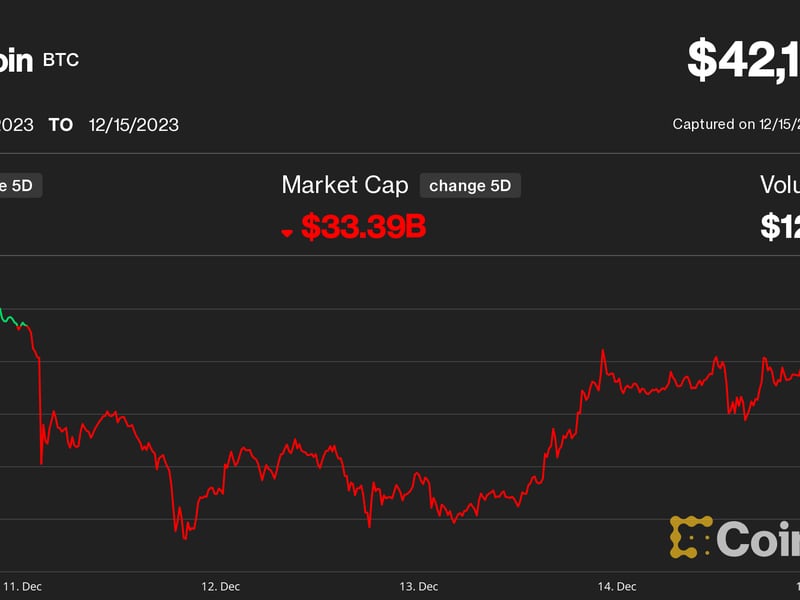First Mover: Derivatives May Have Blunted the Halving’s Volatility Spike
Credit: Shutterstock/Razumov2
First Mover: Derivatives May Have Blunted the Halving’s Volatility Spike
Checking CoinDesk’s Bitcoin Price Index, you’d be forgiven for not seeing evidence that one of the largest events in the cryptocurrency industry’s history had taken place fewer than 48 hours ago.
Wizened crypto greybeards (a status that really only takes about four years of experience in fast-moving digital-asset markets) were less surprised by the lack of price action in response to bitcoin’s third halving: The prior two halvings were similarly dull.
You’re reading First Mover, CoinDesk’s daily markets newsletter. Assembled by the CoinDesk Markets Team, First Mover starts your day with the most up-to-date sentiment around crypto markets, which of course never close, putting in context every wild swing in bitcoin and more. We follow the money so you don’t have to. You can subscribe here.
Prices don’t suddenly go parabolic the moment the block reward gets cut in half. Such a fundamental structural change on the blockchain network appears to exert its influence over weeks and months, not hours or days.
First Mover pointed out a few days ago that immediate market impact of the 2012 and 2016 halvings proved marginal, with prices sliding 0.5% and 2.3%. Zooming out, bitcoin was up 80-fold a year after the first halving; it climbed 30-fold a year and a half after the second halving, reaching an all-time high of $20,000 in December 2017.
So what’s the long-term effect of the 2020 halving? If history’s any guide, bitcoin’s got some soaring ahead.
Maybe this time is different, though. One thing that really struck home was a blog post from CME, the world’s largest derivatives exchange (which began offering bitcoin futures in December 2017), discussing why the 2020 halving might be different from the ones before:
“For the first time there is a robust derivatives market for bitcoin in both futures and options. In previous halvings, market participants could only express their views on bitcoin through the spot market. This time around, firms looking to hedge or speculate have the ability to trade a derivative rather than the underlying and so they can express both positive and negative views on bitcoin’s price action.”
To wit, what’s changed is the ease of going short.
Crypto derivatives were a fringe affair at the 2016 halving. BitMEX was pretty much the only show in town, Deribit, now a key hub for bitcoin options trading, had barely launched.
Trading records don’t reach back far enough to examine how the crypto derivatives market has evolved since the past halving. But using data from crypto analytics site Skew, it’s possible to glean the growth just over the past year, when big spot exchanges like Binance, OKEx and Huobi started muscling in.
Across the board, aggregated derivative-exchange volumes have trended upwards:

Rich Rosenblum, co-founder of cryptocurrency trading firm GSR, noted in an email that recent weeks have delivered a boom in volume to crypto product providers.
“The majority of volumes this week have been in futures rather than spot,” he wrote. “We’re seeing that on the OTC side. For example, GSR has had its biggest May ever and we’re only 12 days in.”
One might think that the proliferation of crypto derivatives would increase crypto’s price volatility. When over-leveraged BitMEX traders have their 100x positions forcefully liquidated, the swings can get pretty extreme.
But derivatives also aid price discovery. Traders might get it wrong, but the act of putting money down forces them to be realistic.
And the two-way betting via derivatives markets might help keep the price in a tighter range.
That might help explain why the halving was such a dull affair, at least initially: Derivatives may have thwarted any volatility spike.
Tweet of the day

Bitcoin watch

BTC: Price: $9,021 (BPI) | 24-Hr High: $9,001 | 24-Hr Low: $8,662
Trend: Bitcoin has risen back to $9,000 in the last 24 hours. However, it’s too early to call a bull revival, as a key bearish pattern confirmed earlier this week is still valid
Bitcoin dived out a rising wedge pattern on Monday, indicating an end of the rally from the March low of $3,867 and putting sellers back into the driver’s seat. A move above $9,170 is needed to invalidate the bearish reversal signaled by the wedge breakdown.
That looks unlikely as other indicators, too, have turned bearish. For instance, the 14-day relative strength index has violated the two-month ascending trendline. And the MACD histogram has crossed below zero, indicating a bearish shift in momentum, as noted Tuesday.
Further, there are signs of trend reversal on longer duration chart. Notably, the cryptocurrency fell by 12% over the weekend, producing a big bearish engulfing candle on the 3-day chart. The candle is backed by the highest sell volume (red bars) since January 2018.
So, a deeper pullback cannot be ruled out. The immediate support is seen at $8,804 (Asian session low). A violation there would reinforce the wedge breakdown and will likely yield a quick slide to the 200-day average at $8,000.
On the higher side, the halving day high of $9,565 is the level to beat for the bulls.

Disclosure Read More
The leader in blockchain news, CoinDesk is a media outlet that strives for the highest journalistic standards and abides by a strict set of editorial policies. CoinDesk is an independent operating subsidiary of Digital Currency Group, which invests in cryptocurrencies and blockchain startups.









